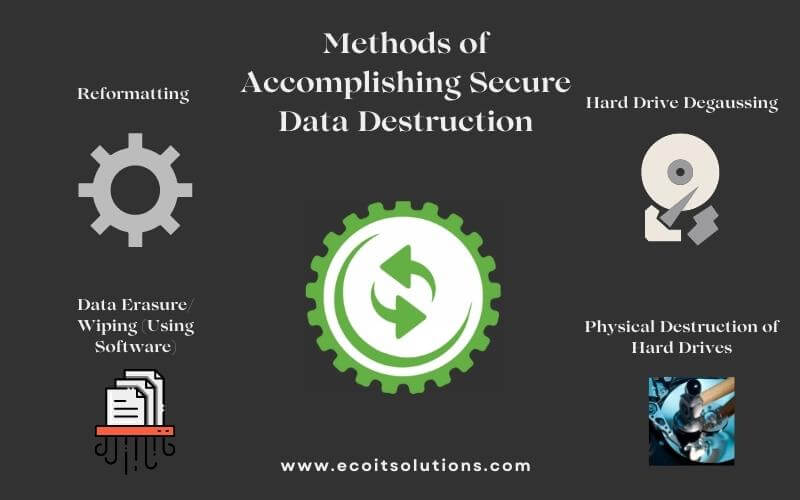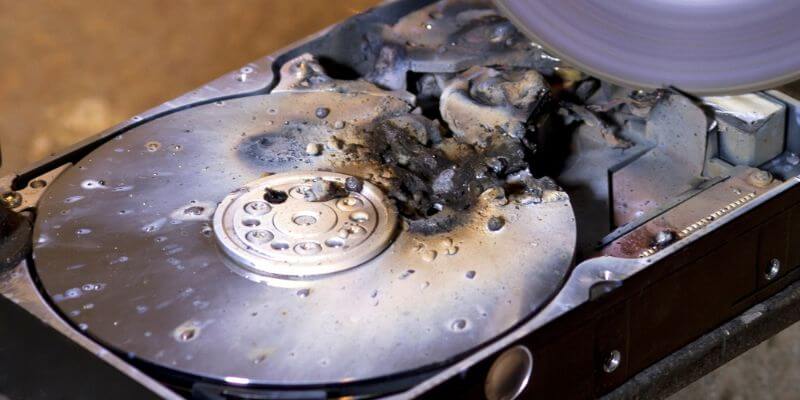Secure data destruction is the process of removing data from storage media using various methods (which I will discuss later) to render the data utterly irrecoverable by anyone. Data destruction can be achieved in many ways; some methods are better than others. Before even getting into the methods, it’s better to understand why it’s essential.
After reading this blog, you will have a deep understanding of the following things:
- What is secure data destruction?
- Why is it Important?
- What are the methods to accomplish data destruction?
- Which methods are suitable for different requirements?
- Types of secure data destruction services.
- How to choose vendors for your secure data destruction needs?
Okay, there’s a lot to unpack here, and let’s get started! With organizations becoming increasingly digital, data storage requirements are also increasing. It only makes sense for organizations to get rid of the data after it has served its purpose on the media devices. Countries have established privacy-related rules to ensure that people’s data is handled and appropriately destroyed, we’ll unpack this below.
Why is Secure Data Destruction Required?
Why should organizations bother with data destruction? And why should the data destruction be SECURE? There are reasons why the government mandates an effective data retention policy for users.
Your organization may handle users’ sensitive information such as their medical history, credit card info, addresses, and phone numbers while delivering online services. Alternatively, stored on HDDs or media drives, could hold trade secrets & valuable IP that are critical to the success of your business. This information could be misused for malicious intent without regard for impact or damages caused. Let’s take a glance at why secure data destruction ought to be implemented…
Protecting Business from Data Destruction Related Laws
Upholding people’s privacy is taken pretty seriously in democratic nations, which is why the law backs people’s right to privacy in many countries, including Australia. Besides, business is a group of people, and as people, we must respect boundaries. Although many citizens share similar concerns, businesses also have profit motives which can sometimes lead them to ignore boundaries and exploit others’ confidential information for profit.
To curb such practices, the Australian government drafted the Privacy Act and many other supporting laws which stipulate strict requirements for businesses regarding Information Destruction and Retention Requirements.
As per law, when a business is expected to destroy the customers’ data, it must do so with secure data destruction. Failing to comply with such regulations can incur hefty fines for the business. So, data sanitization is essential for businesses regardless of what information is collected and stored.
Maintaining Data Security
Even if not mandated by the government, businesses must think seriously about secure data destruction because competitors can use leaked data. Companies with Intellectual Property and other Trade Secret materials in their media drives should go through secure hard drive destruction, especially if they plan to upgrade their systems. Doing so would ensure the data security of the company and prevent any economic woes as a result of data leakage.
In certain cases, it becomes necessary to remove your data from certain servers and devices. This is to make sure no one can use any residual information against you. Although wiping all data may seem like a loss; you have no other choice if it means protecting your privacy or getting compromised. Of course – ensure essential information is backed up first! When it comes to business, there will be times when you will need to destroy all data in your system. This is a way to make sure no company information will fall into the wrong hands.
You may also like: Importance of Data Destruction in Cybersecurity
Methods of Accomplishing Secure Data Destruction
Secure hard drive destruction is the most used service by businesses because it is common practice to store data on hard drives. Therefore, hard drives are the storage devices most focused on the blog for data destruction. I have also discussed CD drives, backup tapes, and other devices used in legacy systems, and how data destruction is carried out for these, discussed later in this blog. Depending upon the number of devices to process, organizational requirements, and the nature of destruction intended, several methods can carry out data destruction. Moreover, here is a closer look at each secure data destruction method and the pros and cons connected with each method.
Reformatting
Reformatting and deleting files from a device is one of the most basic data destruction methods. Although it doesn’t ‘securely’ erase the file from the system, it is, however, a good start. Reformatting is the act of deleting an entire hard disk sector and is a much milder form of erasing data compared with destroying a hard drive.
Advantages of Data Destruction by Reformatting
- Easily doable.
- It is a speedy method of erasing data.
- Does the job for individual users.
Disadvantages of Data Destruction by Reformatting
- Data can still be extracted.
- Even though it’s fast, it doesn’t completely guarantee complete data destruction.
- For organizations with a lot of devices and sensitive requirements, it’s not enough.
Suitability of Reformatting as Data Destruction Method
Reformatting is suitable for individuals with not so stringent requirements, but for organizations with sensitive data, this method is quite futile as data can be extracted from the reformatted storage device.
Data Erasure/ Wiping (Using Software)
Data erasure/ overwriting is the process of covering the code of a particular file with a pattern of ones and zeroes. Let’s make it more straightforward. Files on the hard drive are laid out as a series of 0’s and 1s. In the overwriting process, those 0’s and 1’s are removed and overwritten with another file (different series of 0’s and 1’s).
Overwriting can be done more than once to make sure that the data is deleted. The pattern you overwrite does not need to be random. Overwriting does work, but it takes quite a while to achieve. Using software such as Blancco, data can be easily erased and verified many times over to ensure the data destruction has been carried out, leaving no trace of old data behind.
What’s even more lucrative is that the hard drives that undergo the data erasure method are reusable and can be redeployed in a business as required, saving businesses a lot of money. Or in some cases, these devices can be resold and extract value.
Advantages of Data Erasure
- Simple deployment as this method is software-based.
- It is a very effective and secure method of erasing data.
- Data erasure is flexible and can be conducted in a live environment on-premises.
- Devices that undergo data erasure can be reused again.
Disadvantages of Data Erasure
- Requires expertise and trained technicians to process devices.
- Can be time-consuming, depending on the size of HDDs and quantity.
Suitability of Data Erasure as Data Destruction Method
Software-based data erasure is suitable for most organizations as it can be conducted in a live environment without disrupting the system. It’s not as physically strenuous, messy, and logistically complicated as physical destruction. Having said that, organizations wanting to process a huge number of HDDs and wish to destroy data fast, prefer hard drive shredding.
Hard Drive Degaussing
Hard drive degaussing is a method of data destruction that involves a strong magnetic field to remove the data. In this method, the hard drives are subjected to strong magnetic waves to remove the data stored in them. This is a rather complex process of destroying data from a hard drive and not universally applicable to all memory types.
Degaussing is a comparatively impractical method of data destruction as it can be a bit complex and not accessible to most people. Moreover, this method does not apply to SSD and flash drives. So, hard drive degaussing is rather impractical, a somewhat redundant method, and not preferred by many industries.
Advantages of Hard Drive Degaussing
- Degaussing hard drives can destroy the data on them with minimal effort.
- Hard drive degaussing can be used to process huge volumes of storage devices.
Disadvantages of Hard Drive Degaussing
- The cost of degaussing a hard drive is a bit high.
- Requires a special degaussing machine.
- Hard drives processed using degaussing cannot be reused and are turned into e-waste.
- It is completely unusable for SSDs and Flash media drives.
Suitability of Hard Drive Degaussing as Data Destruction Method
Using hard drive degaussing along with physical destruction can provide a high level of data security if data centers or businesses want to render hard drives completely useless. That said, hard drive degaussing is not suitable for SSDs, and most modern drives are SSDs.
Physical Destruction of Hard Drives
Physical destruction of the hard drive is a method where the hard drive is either crushed and destroyed or pulverized into small segments of fine powder to destroy the data stored in it. Physical destruction is scalable as a considerable volume of hard drives can be crushed using a portable machine or an industrial-grade shredder. Physical destruction of the hard drive is pretty straightforward and can be accomplished by any service provider having access to the relevant equipment.
Physical destruction of the hard drive is carried out a bit differently for Hard Disk Drive (HDDs) and Solid State Drive (SSDs) as they store data differently. For HDDs, larger particles are permissible, but for complete physical destruction of SSDs, the size of the shredder must be set such that the Drive is crushed or pulverized to an even smaller size. Usually, the smaller (or finer) the pulverized SSD, means more secure destruction.
Advantages of Physical Hard Drive Destruction
- Physical HDD or SSD destruction is scalable and used for processing huge volumes of data storage devices.
- It is the most cost-effective method for complete disposal.
- It can be used for hard drives, SSDs, flash drives, CDs, and all kinds of storage devices.
Disadvantages of Physical Hard Drive Destruction
- Physical destruction of drives does not allow for reusability or remarketing but it does ensure complete data destruction.
Types of Secure Data Destruction Services
Secure data destruction is best carried out with the help of a certified and experienced service provider, as the process of data destruction requires technical expertise. Also, service providers should provide a serial number list with a certificate of data destruction (or data erasure) which shifts the liability to them. In the case that data has not been destroyed, the service provider will be liable for any damages related to a leak.
For businesses looking to find data destruction services, there are two major types of data destruction services that you need to be aware of. Let us discuss the types of secure data destruction services and discover what works best for your business.
Off-Site Data Destruction Services
Off-site data destruction services are carried out by transporting the storage devices and IT assets to the processing facilities of the service provider. The IT assets are transported to the service provider’s premises securely and then processed there. Businesses should be careful to select a service provider that ensures secure transportation of IT assets to their processing site. For businesses with large quantities of HDDs or media devices, bulk data destruction services are required, and thus, you need a service provider capable of handling this project.
On-Site Data Destruction Services
On-site data destruction services are for those businesses wanting better security and cannot risk their IT assets being transferred outside of their premises unless destroyed. The technicians and experts visit the data center/business along with the required equipment and carry out secure data destruction there. The representatives of the business can oversee the serial number capture and hard drive destruction process. This method is adopted by businesses with high-security requirements.
How To Choose a Data Destruction Service Provider?
For businesses requiring secure data destruction, choosing a reliable and trusted service provider is necessary. So, businesses/data centers seeking to destroy their data need to choose a vendor that has a proven track record of security in the data disposal process. The chosen vendor/service provider should conduct certified processes, capture all serial numbers of every media drive handled, and provide a certificate of destruction.
Secure Processing Facilities
Data Destruction service providers need to have secure processing facilities. No person should be able to enter without permission or access data bearing IT assets that could potentially be tampered with.
Standard Processes and Following Best Practices
Data destruction vendors that follow secure management processes are preferred over companies that work without set guidelines. Companies that remain up to date with data destruction trends and follow best industry practices should be preferred.
Correct Equipment and Trained Technicians
Secure data destruction can only be achieved with skillful technicians and proper equipment. Regardless of the method used to achieve data sanitization, skillful human resources and technical standards cannot be substituted for anything else.
Certifications and Reports of Data Destruction
Data destruction can be only considered secure if it is backed by reporting and certification. A service provider that hesitates to provide certificates should not be entertained by businesses. Therefore, a data destruction service provider must provide proper reports of the data destruction process.
In addition to these essential attributes, there may be several other factors that a business or data center should look for when selecting a data destruction service provider. These could include the cost of services, location, availability, or reputation within the industry.
Frequently Asked Questions
Secure data destruction is the process of destroying the data stored on laptops, phones, hard drives, and other electronic devices. Once the destruction is completed, data will be completely unreadable and cannot be accessed by an unauthorized person.
The only best method for making data unreadable is degaussing, which involves a strong magnetic field to remove the data. This not only erases data but also destroys the device.
Your organization may handle users’ sensitive information such as their medical history, credit card info, addresses, and phone numbers while delivering online services. Alternatively, stored on HDDs or media drives could hold trade secrets & valuable IP that are critical to the success of your business. Therefore, secure data destruction’s primary goal is to prevent misusing sensitive and confidential information.
Destroying data is the most effective way to ensure that your data and information does not end up in the wrong hands. It is crucial when decommissioning your equipment, especially if it is going to be resold or recycled.
Basically, the three methods for destroying data are: overwriting, which involves replacing outdated information with new data; degaussing, which consists in erasing the magnetic field of the storage medium; and physical destruction, which involves methods like disk shredding. According to experts, each of these methods has advantages and disadvantages.





Comments
5 responses to “What Is Secure Data Destruction?”
[…] environment. Our services make it easy for you and your IT company to do the same. From secure data destruction and decommissioning to e-waste recycling, we’ve got you covered. Let us know how we can be of […]
[…] happens when the data in your devices or equipment don’t get wiped? In this article, learn about secure data erasure and instances where companies or organisations suffered from data […]
[…] soon be rendered to be ‘old’ or ‘junk’, the first thing that one must do is plan for a data destruction service. How can this save you down the line? Read on to learn […]
[…] and “erase” may technically be synonyms, they are not the same when applied in the context of data destruction. When you delete your files, you simply make it inaccessible to the user. However, when special […]
[…] Data destruction is the process of clearing, eradicating, and making sure that any and all data in a system becomes impossible to reread and reuse. This process helps businesses make sure that no other party can retrieve their files and use them for personal gain. […]